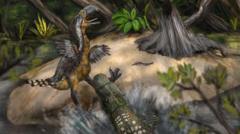Researchers have uncovered compelling evidence that a fearsome 'terror bird' was killed by a larger predator around 13 million years ago. Teeth marks discovered on a fossilized leg bone indicate that a giant caiman, a crocodile-like reptile, may have fatally attacked the avian predator. The findings, published in the journal Biology Letters, stem from meticulous examinations conducted by Colombian palaeontologists.
The terror bird, a top predator that could exceed 2.5 meters in height, was well-adapted to its environment, boasting powerful legs and a hooked beak designed for capturing prey. The leg bone, excavated over 15 years ago in the Tatacoa Desert, revealed distinct bite patterns once researchers compared it to the skulls and teeth of ancient crocodilian species.
While the researchers cannot definitively prove if the caiman killed the bird during the attack or scavenged its remains afterward, the absence of healing on the marks suggests the bird likely died in the confrontation. "That was the last day that bird was on this planet," noted lead researcher Andres Link from the Universidad de Los Andes, highlighting the significance of this prehistoric encounter.
During the Middle Miocene epoch, the humid swampy habitat of the Tatacoa Desert formed an ideal backdrop for the interaction of these apex predators. The leg bone's initial discovery by fossil collector César Augusto Perdomo led scientists to realize the impact of these bite marks, which had been made by a long-extinct caiman species known as Purussaurus neivensis.
Link speculates that this ancient predator was lying in wait for unsuspecting prey near the water's edge. The findings bring new insight into the dynamics of ancient ecosystems and suggest that terror birds may have been more vulnerable to predation than previously believed. "Every piece of a body helps us to understand so much about life on the planet in the past,” Link emphasized, showcasing the importance of fossil evidence in reconstructing historical narratives.



















